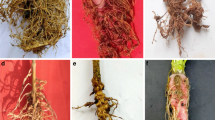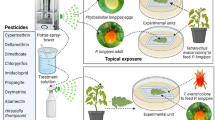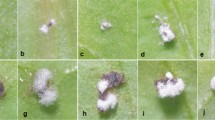Abstract
Background
In this study, commercial bioinsecticides including entomopathogenic fungi, Beauveria bassiana, Metarhizium anisopliae, and Verticillium lecanii, and Spinetoram active ingredient insecticide were evaluated against the tomato leaf miner, Tuta absoluta (Meyrick, 1917) (Lepidoptera: Gelechiidae) larvae.
Main body
The active ingredients were prepared at the recommended concentrations under laboratory conditions and applied to the 2nd instar larvae of T. absoluta by spraying with a hand sprayer. On the 1st, 3rd, 5th, and 7th days of the application, evaluations were made by counting survived individuals. The findings showed that the highest mortality rates were detected in the case of Spinetoram with 56, 60, 88, and 100% on all counting days of the experiments, respectively. The highest mortality rate among bioinsecticides was recorded for M. anisopliae, with 87% mortality on the 7th day of application.
Short conclusion
As a result, Spinetoram was found the most effective insecticide when applied to T. absoluta, followed by M. anisopliae.
Similar content being viewed by others
Background
Tomato (Solanum lycopersicum L.) is an annual vegetable that belongs to the Solanaceae family, native to South and Central America. It has gained an important place with its high nutritional values and the usage in food industry (Keskin and Gül 2004; Canpolat 2016; Gölükçü et al. 2016). Tomatoes are the most produced vegetables worldwide as well as in Turkey. Due to its economic importance, it is essential to protect its plants from diseases and pests. The red spider mites, thrips, whiteflies, aphids, and leaf gallery flies cause damages to vegetables in regions where climate conditions are suitable for pests (Tunç and Göçmen 1995; Ulubilir and Yabaş 1996; Bulut and Göçmen 2000; Güncan et al. 2006). Tomato leaf miner Tuta absoluta (Meyrick, 1917) (Lepidoptera: Gelechiidae), which was first recorded in Turkey in 2009, has become a main pest in intensive tomato-producing areas (Kılıç 2010). T. absoluta larvae attack the leaves, stems, and fruits of the tomato plants. The irregular galleries formed by the larvae feeding result in necrosis on the leaf, and its color turns brown and causes completely drying of the plant. Due to its feeding on the fruits, disease factors occur and the market value of the fruit decreases (Mahmoud et al. 2014; Polat et al. 2016). The pest control, mainly applied by chemical control, enables the destruction of natural enemy populations, and the development of resistant races and residue problems arise (Braz 2000; Siqueira et al. 2000; Öztemiz 2012). For these reasons, it is important to search for alternative methods to chemical control with low risks in terms of environment and human health.
In this study, the commercial bioinsecticides including the entomopathogenic fungi, Beauveria bassiana, Metarhizium anisopliae, and Verticillium lecanii, and the insecticide Spinetoram were evaluated against the 2nd instar larvae of T. absoluta under laboratory conditions.
Main text
Materials and methods
Growing of tomato plants
In the study, the Mercury F1 tomato (Solanum lycopersicum L.) variety seedlings were planted in 1.5-l pots, containing a mixture of soil and peat. The production of tomato plants was carried out in climate rooms at 25 ± 1 °C, 60 ± 5% RH, and 16:8 h photoperiod.
Producing of tomato leaf miner
Tomato leaf miner adults were obtained collected from emission bottle over tomato plants in the greenhouse of Pamukkale University, School of Applied Sciences, Department of Organic Agriculture Business Management in Turkey, and brought to the climate room. These adult individuals were allowed to lay eggs on 15–20-cm height tomato seedlings. In order to increase the pest population and to ensure the continuity of insect stock culture, tomato plants in the climate rooms were renewed periodically. The 2nd instar larvae of T. absoluta were selected from this stock culture to be used in the experiments. The production of tomato leaf miner was carried out under the above climatic room conditions in which the tomato plants were grown.
Commercial bioinsecticides tested
The commercial bioinsecticides tested are given in Table 1. Spinetoram was used as a negative control to be compared to insecticides. The recommended concentrations were placed in sterile distilled water, mixed with the help of a mixer, and used in experiments.
Experimentation
Fresh tomato leaves were placed on moistened blotting papers in Petri dishes. Five individuals of 2nd instar T. absoluta larvae were placed on each leaf, with 5 replications, according to the randomized parcel design. The bioinsecticides, prepared at the recommended concentrations, were sprayed 3 times (average 1–2 mg solution/cm2) on the larvae using a hand sprayer. Distilled water was used in the control. To prevent larval escapes, Petri dishes were wrapped up with parafilm after spraying. Live larvae were recorded on the 1st, 3rd, 5th, and 7th days of the experiment, using a binocular stereo microscope.
Data evaluation
Obtained data were analyzed by one-way analysis of variance (ANOVA), and IBM SPSS® Statistics (version 20.0, August 2011, SPSS Inc., Chicago, IL, USA) package program was used to evaluate the results. To calculate the differences among the group average, the Tukey (1949) multiple comparison test (P < 0.05) was used. However, the percentage of real mortality rates was determined by using the corrected Abbott formula (Abbott 1925). In addition, the estimated time to kill 50% of the insects (LT50) was determined by the Probit analysis program (Finney 1971; Throne et al. 1995).
Results and discussion
The percentage of mortality rates resulting from the application of the bioinsecticides and the insecticide to the 2nd instar larvae of the tomato leaf miner are given in Fig. 1. The highest mortality rates were recorded in the case of the Spinetoram insecticide, which were statistically different than the other experiment bioinsecticides, as 56, 60, 88, and 100% on the 1st, 3rd, 5th, and 7th days, respectively, were recorded. On the 3rd day counts, Spinetoram (60%) was first, followed by M. anisopliae (44%), B. bassiana (28%), and then V. lecanii (16%). On the 5th day counts, the percentage mortality of T. absoluta by M. anisopliae was 56%, B. bassiana 40%, and V. lecanii 36%. On the 7th day counts, the highest mortality rate was recorded in the case of Spinetoram (100%), followed by M. anisopliae (87%) (Table 2).
After the application of B. bassiana and M. anisopliae isolates to first instar larvae of T. absoluta, mortality rates on the 7th day were found as 4.17 and 91.67%, respectively (Inanlı et al. 2012). The soil isolates of B. bassiana and M. anisopliae at a concentration of 1010 spore ml−1 caused 100 and 93.3% mortality for the 4th instar larvae, while these rates were recorded 30 and 23.3% for T. absoluta pupae, respectively. When the same isolates were applied from leaves, the mortality rates were recorded by 90 and 80% in larvae, respectively (Youssef 2015). In another study, the application of B. bassiana isolate at a concentration of 2.5 × 107 spore ml−1 recorded as 95% mortality in larvae (El-Kichaoui et al. 2016). Abdel-Raheem et al. (2015) reported that the LC50 values of B. bassiana, M. anisopliae, and V. lecanii isolates treated at a concentration of 107 spore ml−1 on the 1st, 2nd, and 3rd larval instars of T. absoluta were 0.28 × 105–0.11 × 105–3.25 × 105, 0.45 × 105–0.46 × 105–5.47 × 105, and 0.32 × 105–0.27 × 105–3.28 × 105 conidia ml−1. In Ayele et al. (2020), when AAUM78, AAUM39, and AAUM76 isolates of M. anisopliae were applied on the 2nd and 3rd larval instars of T. absoluta, mortality rates were 88, 90, and 95 and 90, 93.3, and 95.7%, respectively. However, it was reported that URPE-6 and URPE-19 isolates of M. anisopliae showed very high effects on eggs and larvae of T. absoluta (Pires et al. 2010).
The mortality rates of tomato leaf miner larvae, examined based on the time, LT50 values, recorded 0.75, 3.46, 5.51, and 6.48 days for Spinetoram, M. anisopliae, B. bassiana, and V. lecanii, respectively (Fig. 1).
As a result of treated M. anisopliae and B. bassiana isolates at 108 spore ml−1 concentration against T. absoluta larvae, LT50 values were determined as 3.9 and 5.2 days and 82.8 and 60.8% mortality rates (Ndereyimana et al. 2019). The application of the same isolates at a concentration of 2.5 × 109 conidia ml−1 recorded a mortality rate of 87.50% for M. anisopliae and 95.83% for B. bassiana. In addition, LT50 values were determined as 4.82 and 5.01 days, respectively (Tadele and Emana 2017). The LC50 value of M. anisopliae isolate against T. absoluta larvae was reported as 0.34 × 109 conidia l−1 and the LC90 value as 2 × 109 conidia l−1 (Contreras et al. 2014). Also, the LC50 values of B. bassiana and M. anisopliae isolates against T. absoluta larvae under laboratory conditions were 129.4 × 104 and 98.7 × 104 spore ml−1, respectively (Sabbour 2014). In another study, A-Tz1 and A-Tz2 isolates of Aspergillus oryzae at 108 conidia ml−1 concentration, it was reported that T. absoluta mortality rate 70% for larvae and 84.5% for pupae and adult emergence was prevented by 74.4% in 3 days post-application period (Zekeya et al. 2019).
Conclusion
As a result of the study, Spinetoram insecticide had the highest mortality rate, followed by M. anisopliae bioinsecticide. Further studies under field conditions are needed.
Availability of data and materials
All data generated or analyzed during this study are included in this manuscript.
Abbreviations
- CFU:
-
Colony forming units
- DAA:
-
Days after application
- ANOVA:
-
Analysis of variance
References
Abbott WS (1925) A method of computing the effectiveness of an insecticide. J Econ Entomol 18(2):265–267
Abdel-Raheem MA, Ismail IA, Abdel-Rahman RS, Abdel-Rhman IE, Naglaa FR (2015) Efficacy of three entomopathogenic fungi on tomato leaf miner, Tuta absoluta in tomato crop in Egypt. Swift J Agri Rese 1(2):15–21
Ayele BA, Muleta D, Venegas J, Assefa F (2020) Morphological, molecular, and pathogenicity characteristics of the native isolates of Metarhizium anisopliae against the tomato leafminer, Tuta absoluta (Meyrick 1917) (Lepidoptera: Gelechiidae) in Ethiopia. Egypt J Biol Pest Cont 30(59):1–11
Braz J (2000) Initial studies of mating disruption of the tomato moth, Tuta absoluta (Lepidoptera: Gelechiidae) using synthetic sex pheromone. J Braz Chem Soc 11(6):621–628
Bulut E, Göçmen H (2000) Pests and their natural enemies on greenhouse vegetables in Antalya. Bull OILB Srop 23(1):33–37
Canpolat S (2016) Important diseases seen in tomato and its struggle. Turk Seed Grow AssoJ 17:55–59
Contreras J, Mendoza JE, Martínez-Aguirre MR, García-Vidal L, Izquierdo Bielza P (2014) Efficacy of enthomopathogenic fungus Metarhizium anisopliae against Tuta absoluta (Lepidoptera: Gelechiidae). J Econ Entomol 107(1):121–124
El-Kichaoui A, El-Shafai A, Muheisen H, Mosleh F, El-Hindi M (2016) Safe approach to the biological control of the tomato leafminer, Tuta absoluta, by entomopathogenic fungi Beauveria bassiana isolates from Gaza strip. Int J Appl Res 2(4):351–355
Finney DJ (1971) Probit analysis, 3rd edn. CambridgeUniversity Press, New York, p 333
Gölükçü M, Toker R, Tokgöz H (2016) Nutritional properties of tomatoes and evaluation in food industry. Turk Seed Grow Asso J 17:46–51
Güncan A, Madanlar N, Yoldaş Z, Ersin F, Tüzel Y (2006) Pest status of organic cucumber production under green house conditions in İzmir (Turkey). Turk J Ento 30(3):183–193
Inanlı C, Yoldaş Z, Birgücü AK (2012) Effects of entomopathogenic fungi, Beauveria bassiana (Bals.) and Metarhizium anisopliae (Metsch.) on larvae and egg stages of Tuta absoluta (Meyrick) (Lepidoptera: Gelechiidae). J Agri Facu Ege Uni 49(3):239–242
Keskin G, Gül U (2004) Tomato. Agri Eco Res Inst-Overview 5(13):1–4
Kılıç T (2010) First record of Tuta absoluta in Turkey. Phytoparasitica 38(3):243–244
Mahmoud YA, Ebadah IMA, Abd-Elrazik AS, Abd-Elwahab TE, Deif SH (2014) Efficiency of different colored traps baited with pheromone in capturing tomato adult moth, Tuta absoluta (Meyrick) (Lepidoptera: Gelechiidae) during summer plantation. World Appl Sci J 30(4):406–412
Ndereyimana A, Nyalala S, Murerwa P, Gaidashova S (2019) Pathogenicity of some commercial formulations of entomopathogenic fungi on the tomato leaf miner, Tuta absoluta (Meyrick) (Lepidoptera: Gelechiidae). Egyp J Bio Pest Control 29(70):1–5
Öztemiz S (2012) The tomato leafminer [Tuta absoluta Meyrick (Lepidoptera: Gelechiidae)] and it’s biological control. J Agri Nat 15(4):47–57
Pires LM, Maraques EJ, Oliveria VD, Alves SB (2010) Selection of isolates of entomopathogenic fungi for controlling Tuta absoluta (Meyrick) (Lepidoptera: Gelechiidae) and their compatibility with insecticides used in tomato crop. Neotropical Ento 39(6):977–984
Polat B, Özpınar A, Şahin AK (2016) Studies of selected biological parameters of tomato leafminer Tuta absoluta (Meyrick), (Lepidoptera: Gelechiidae) under natural conditions. Phytoparasitica 44(2):195–202
Sabbour MM (2014) Biocontrol of the tomato pinworm Tuta absoluta (Meyrick) (Lepidoptera: Gelechiidae) in Egypt. Middle East JAgri Res 3(3):499–503
Siqueira HAA, Guedes RNC, Picanco MC (2000) Insecticide resistance in populations of Tuta absoluta (Lep.: Gelechiidae). Agri Forest Ento 2(2):147–153
Tadele S, Emana G (2017) Entomopathogenic effect of Beauveria bassiana (Bals.) and Metarhizium anisopliae (Metschn.) on Tuta absoluta (Meyrick) (Lepidoptera: Gelechiidae) larvae under laboratory and glasshouse conditions in Ethiopia. J Plant Patho & Micro 8(5):1–4
Throne JE, Weaver DK, Chew V, Baker JE (1995) Probit analysis of correlated data: multiple observations over time at one concentration. J Eco Ento 88(5):1510–1512
Tukey JW (1949) Comparing ındividual means in the analyses of variance. Biometrics 5(2):99–114
Tunç İ, Göçmen H (1995) Notes on two greenhouse pests, Polyphagotarsonemus latus (banks) (Acrina, Tarsonemidae) and Frankliniella occidentalis (Pergande) (Thysanopıera, Thripidae), found in Antalya. Turk J Ento 19(2):101–109
Ulubilir A, Yabaş C (1996) Pest and beneficial fauna of under cover vegetables and their distribution in the Mediterranean region of Türkiye. Turk J Ento 20(3):217–228
Youssef NA (2015) Efficacy of the entomopathogenic nematodes and fungi for controlling the tomato leaf miner, Tuta absoluta (Meyrick) (Lepidoptera: Gelechiidae). Arab Uni J Agric Sci, Ain Shams Univ Cairo 23(2):591–598
Zekeya N, Mtambo M, Ramasamy S, Chacha M, Ndakidemi PA, Mbega ER (2019) First record of an entomopathogenic fungus of tomato leafminer, Tuta absoluta (Meyrick) in Tanzania. Biomed Sci Technol 29(7):626–637
Acknowledgements
Not applicable
Funding
Not applicable
Author information
Authors and Affiliations
Contributions
ABE, OE, and İK collaborated in the creation of the manuscript. ABE carried out the experiments, recorded the data, interpreted the results, and wrote the manuscript. The authors read and approved the final manuscript during the present study.
Corresponding author
Ethics declarations
Ethics approval and consent to participate
Not applicable
Consent for publication
Not applicable
Competing interests
The authors declare that they have no competing interests.
Additional information
Publisher’s Note
Springer Nature remains neutral with regard to jurisdictional claims in published maps and institutional affiliations.
Rights and permissions
Open Access This article is licensed under a Creative Commons Attribution 4.0 International License, which permits use, sharing, adaptation, distribution and reproduction in any medium or format, as long as you give appropriate credit to the original author(s) and the source, provide a link to the Creative Commons licence, and indicate if changes were made. The images or other third party material in this article are included in the article's Creative Commons licence, unless indicated otherwise in a credit line to the material. If material is not included in the article's Creative Commons licence and your intended use is not permitted by statutory regulation or exceeds the permitted use, you will need to obtain permission directly from the copyright holder. To view a copy of this licence, visit http://creativecommons.org/licenses/by/4.0/.
About this article
Cite this article
Erol, A.B., Erdoğan, O. & Karaca, İ. Effects of some bioinsecticides on the tomato leaf miner, Tuta absoluta (Meyrick, 1917) (Lepidoptera: Gelechiidae). Egypt J Biol Pest Control 31, 4 (2021). https://doi.org/10.1186/s41938-020-00346-6
Received:
Accepted:
Published:
DOI: https://doi.org/10.1186/s41938-020-00346-6





